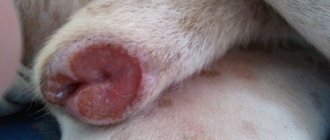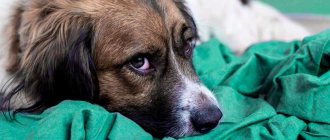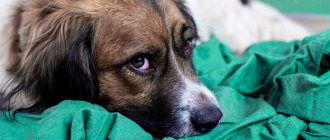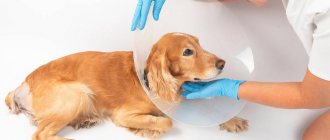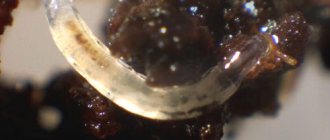Often, owners of dogs prone to allergic reactions are faced with many problems “secondary” to allergies, namely bacterial skin lesions (pyoderma).
This term combines several groups of diseases, which include: bacterial inflammation of the surface layer of the epidermis (upper part of the skin), bacterial folliculitis and furunculosis, as well as septic inflammation of the subcutaneous fatty tissue.
Various manifestations of pyoderma are the earliest and most noticeable clinical symptoms of the onset of development or exacerbation of one or another type of allergic reaction in dogs. Often, the development of microbial inflammation on the skin worsens the allergy situation as a whole: itching and inflammation intensify, an unpleasant odor appears, hair falls out, in rare cases the temperature rises, pain appears and appetite disappears. It is important for both the owner and the veterinarian to understand the fact that pyoderma by itself never occurs, that this group of diseases is always secondary to any primary disease. The most common primary diseases are allergies, some diseases of the endocrine system (hypothyroidism, hyperadrenococticism), anatomical features (most often massive skin folds). In order to prevent the re-development of microbial inflammation of the skin, it is important to identify and control this primary disease.
In today's article we will talk about a very common manifestation of pyoderma of the superficial layer, namely acute weeping dermatitis in dogs. Sometimes you can come across the term “acute wet dermatitis in dogs,” but in general veterinary dermatologists are accustomed to calling this disease “pyotraumatic dermatitis” or “hot spot,” which translated means “hot spot.”
From the name, it is generally clear that the main clinical signs of weeping dermatitis in dogs will be: itching, pain, copious discharge of pus, and redness. In the future, in the absence of help, in a few days a simple superficial inflammation can develop into deep furunculosis, which will complicate the prognosis and treatment, so do not delay a visit to the veterinarian.
Types of eczema and causes of their appearance
Eczema is an inflammatory process that spreads to the upper and deeper layers of the skin.
Edema occurs as a result of an immune reaction to external or internal irritants. Dermatological diseases in dogs are classified according to etiology, duration and nature of the disease. There are 2 types of eczema based on duration:
- Spicy. The disease manifests itself in the form of pronounced symptoms: inflammation quickly spreads throughout the body, accompanied by itching and discomfort.
- Chronic. The lesions persist throughout the pet's life. This form is difficult to treat - therapy can take 4 to 5 years.
According to the nature of its course, eczema can be dry or wet. In the first case, the skin peels off greatly, the dog sheds and itches. In the latter, the epithelium becomes moist to the touch. The surface of the skin acquires an unhealthy shine.
Take the Attention Test! Find 10 differences! (click right here!)
Find the answer Are you bothered by some problem or question? Enter “Breed” or “Name of the problem” into the form, press Enter and you will find out everything about the issue that interests you.
There are causes of the disease:
- Traumatic. Purulent inflammation occurs in the wound area. Eczema often develops as a result of blows or strong friction from the collar at the base of the neck. In dogs living on the street, skin inflammation occurs due to frostbite, burns or insect bites. If wounds become infected, weeping eczema develops.
- Reflex. Negative reaction of the body in response to external and internal stimuli. The last group includes any organ damage that is accompanied by the release of pus and toxins into the blood, parasitic infestations and hormonal imbalance. External irritants include allergens: dust, insect and plant poisons, mites. Dry eczema becomes wet only after pathogenic bacteria come into contact with the skin.
- Neuropathic. The rarest type of eczema, manifested in the form of autonomic disorders. The disease can be either congenital or acquired against the background of another pathology. Symptoms of eczema occur after exposure to severe stress and emotional turmoil: moving, fear, physical abuse of a pet. With eczema of neuropathic etiology, there is symmetrical inflammation on the stomach, back or upper part of the dog's head.
Flea infestation
Symptoms:
- The dog is constantly itching, all over, here and there. The scratch is very characteristic: fast and furious.
- The animal sleeps poorly and nervously wanders around the apartment in search of relief from the unbearable itching. The dog becomes irritable and restless.
- A characteristic sign of a dog being infected with fleas: the pet begins to sharply bite into the skin, clattering its teeth, trying to catch the irritant.
- In advanced cases, the dog may develop an allergy to fleas. The eyes begin to water, the skin becomes covered with a rash, small blisters and pustules that burst and form ulcers and scabs. The animal can scratch such formations until there are bloody wounds and bald patches.
- If treatment is not started in time, fleas will lay eggs in the animal’s fur. They can be easily seen. But in this case, dogs with dark colors, so to speak, find themselves in a more advantageous situation. The fact is that flea eggs are light grains, in appearance somewhat reminiscent of grains of rice, only much smaller. The size of the eggs does not exceed one millimeter.
- If you run your hand over a dog’s fur, then in addition to fleas, larvae and eggs quickly hiding and escaping in the undercoat, you can see dark grains (parasite feces) on the animal’s fur.
- If it is difficult for the owner of a four-legged dog to determine whether his pet has fleas, then the best way to identify insects is to run a bath of water and bathe the dog. Upon contact with water, fleas will begin to move onto the animal’s head or jump into the water.
Treatment:
1. Bathe the animal with flea shampoo.
2. Sanitize the pet’s bedding and the entire room.
Prevention:
- Drops against fleas.
— Antiparasitic collar. ===================================================== ===================================================== ===================================================== =====================================================
What affects eczema
Factors that can trigger the development of skin diseases include:
- Improper animal care: lack of hygiene, infrequent brushing of dogs with long hair, unbalanced diet;
- Congenital diseases;
- Predisposition to developing allergies, weak immunity;
- Severe stress;
- Increased humidity between the folds in some breeds: Shar Pei, pug, mastiff, bulldog;
- Prolonged exhaustion;
- Poor skin condition: increased dryness, infectious disease, disruption of the sebaceous glands;
- Hormonal imbalance: leads to a disorder of general metabolism, due to which blood supply to the subcutaneous fat tissue deteriorates and eczema appears.
Which breeds are more susceptible
Pets with peculiar folding of the skin and a highly developed undercoat are more likely to develop eczema than their relatives. These include the following breeds: Shar Pei, Bloodhound, Neapolitan Mastiff, Bulldogs, Pekingese, Pug, Great Danes, Shepherd Dogs, Newfoundlands.
This does not mean that your pet will necessarily develop eczema. This means that in the presence of provoking factors, the likelihood of the disease occurring is much greater than in other breeds.
How it develops
The disease develops in several main stages:
- In the affected area, the skin turns red and swells. Erythema gradually develops. The pet is not able to tolerate the severe itching that occurs at the site of the pathology, so it begins to itch with the help of its claws. As a result, wounds appear at the site of scratching, into which the dog introduces infection.
- In the area of redness, papules form - small tubercles with a dense structure. The itching does not go away.
- Papules transform into vesicles. At this point, they increase in size and fill with liquid.
- If a dog introduces an infection into the wound with its claws, pathogenic microorganisms begin to actively multiply inside the blisters. As the bacterial colony grows, the liquid inside the vesicles becomes cloudy. In response to the development of infection, the activity of leukocytes increases, which begin to fight bacteria. As a result, the fluid becomes filled with dead bacteria and immunocompetent cells, which turns into pus. It splits the vesicle wall and flows out.
- The liquid gets into other wounds from scratching the claws, which causes repeated irritation of the skin and weeping ulcers.
If the dog’s immunity is able to cope with the infection, dry eczema develops at the site of the wounds.
Symptoms in different forms
The first symptom of the disease is restless behavior caused by severe itching. The animal constantly itches, gnawing into the affected area with its teeth. At this stage, the owner may notice erythema.
Symptoms and treatment for weeping and dry eczema in dogs are different. In the first case, symptoms are accompanied by:
- pain (the pet does not allow you to touch the affected areas and whines while scratching);
- moisturizing the skin surface;
- chills and fever;
- loss of appetite and severe weight loss;
- apathy, nervousness and sleep disturbances;
- bowel disorder.
At the site of wet ulcers, focal alopecia is noted. Wounds appear with ichor flowing out, which sticks the fur together. Foci of inflammation gradually merge, increasing the affected area.
The dry type of pathology is accompanied by more severe itching in the absence of pain. In areas of peeling, the hair stands on end and thins out a little, and then begins to fall out in clumps. Dandruff and seborrheic plaques form on the problem area. Most often the sternum, back and withers are affected.
Symptoms
At the initial stage, the pathological process occurs unnoticed by humans, especially if the dog has thick or long hair. You can suspect the presence of wet eczema in your pet based on the following signs:
- The dog regularly scratches the same place, whining in pain;
- In this area, the hair falls out a lot and does not fit tightly to the body;
- At the site of baldness, areas of redness form, a rash develops, and the skin temperature rises;
- Because of the pain, the dog does not allow the person to examine the lesions, runs away and hides;
- Sweat glands in dogs are located primarily on the paw pads and nose, but not throughout the body, so if there is moisture under the fur, you should take the animal to the veterinarian;
- With a long course of the disease, the general condition of the pet worsens, signs of intoxication appear: dehydration, dyspeptic disorders, apathy;
- The dog refuses food, his body temperature rises, and physical activity decreases.
Is eczema transmitted to humans and other animals?
Eczema is a non-contagious disease, that is, it is not transmitted to humans or other animals. However, if the cause of the lesions is due to external parasites or ringworm, other animals may have similar symptoms.
Fleas can also bite humans, and dermatophytosis can form lesions on the skin. There are many reasons for the occurrence of eczema. Symptoms may disguise it as other skin diseases. In this regard, diagnosis and visiting a veterinary clinic should not be neglected.
Is it possible to help yourself?
There are no veterinary medications for weeping eczema. Not all dog owners will be able to identify pathology and take action. Self-treatment leads to a worsening of the animal’s condition, so trying to eliminate eczema at home is impossible.
If you find moist areas with rashes and ulcers, you will need to seek help from a veterinarian. The specialist is informed:
- What has your pet eaten over the past month?
- What conditions does the dog live in?
- When and how the scratchings were discovered;
- Is there no appetite?
- How often does your dog empty its bowels and bladder?
Skin disease requires complex treatment and compliance with all medical recommendations. After determining its cause, the veterinarian will prescribe a course of antibiotic treatment, diet therapy and ointments.
Hives
Hives are an acute allergic reaction that manifests itself as a rash of small blisters on the surface of the skin.
Symptoms:
- Small swellings appear on the ears, face or even tongue, resembling blisters or traces of nettle burns.
“Sometimes hair starts to fall out in these places.
— Since the dog experiences severe and constant itching, it begins to constantly scratch and even scratch its skin, as a result of which numerous scratches appear on it, especially numerous on the face.
- In more severe cases, the animal experiences distinct difficulty in inhaling air. This happens due to swelling and swelling of the mucous membranes of the upper respiratory tract.
— In the most dangerous situations, the tissues of the pet’s face are literally “swept away,” and the lips and nose become swollen.
Treatment:
1. The main means of combating an allergic reaction in the form of urticaria is to take antihistamines (Suprastin, Zyrtec, Tavegil, etc.).
2. In severe cases, accompanied by swelling and difficulty breathing, an infusion of 10% calcium chloride solution and the use of adrenaline are prescribed.
Take your pet to the vet immediately if you notice the following:
- When your dog strains and wheezes while trying to breathe.
- In cases where the face and lips swell with urticaria.
- You should also contact a veterinarian when the clinical picture of urticaria does not subside a day after the first signs of pathology appear.
============================================================================================================================================================================================
Treatment of weeping eczema at the veterinarian
After bringing in an animal with suspected skin disease, the veterinarian conducts an external examination. The specialist interviews the dog owner, collecting anamnesis, and identifies characteristic symptoms of the pathology. After confirming the diagnosis, he determines the further treatment regimen:
- Conducts unscheduled flea and tick treatment;
- Collects feces, blood and urine for analysis to exclude parasitic infestation;
- The places where the animal's body comes into contact with collars, harnesses and bandages are checked to detect hidden wounds;
- If the cause of the disease is diseases of the internal organs, a course of appropriate medications is prescribed.
The owner must clear the apartment of potential allergens to reduce the risk of re-development of the disease.
In the chronic form of the pathology, infusion therapy is prescribed. Droppers allow you to drive the drug through the blood in a few minutes, which will affect all parts of the body. This is necessary because prolonged wet eczema quickly spreads over the entire surface of the skin and begins to poison the body. The IV solution consists of saline solution, 5% glucose solution and Ringer's solution.
Liver protection
If the development of a skin disease provokes liver damage, the dog is prescribed hepatoprotectors:
- Legaphyton. The drug is prescribed at the rate of 1 tablet per 10 kg of body weight, containing 200 mg of the active substance. If the oral agent contains 50 mg of the active compound, then the dosage increases to 1 tablet per 2.5 kg of dog weight.
- Hepatovet. A single dosage is 1 ml of solution per 10 kg of dog weight. The daily dose of the drug reaches 2-3 ml. The product is poured into the pet's mouth.
- Covertal. The maximum daily dosage should not exceed 4 ml. The solution is administered intramuscularly or subcutaneously at the rate of 0.1 ml per 1 kg of weight.
- Hepatoject. The solution is administered subcutaneously, intravenously or intramuscularly in a dosage of 2 to 5 ml.
Hepatoprotectors are prescribed for complex treatment to protect the liver from the negative effects of antibiotics. Treatment of wet eczema may require long-term use of many tablets and the administration of large amounts of solutions, due to the toxicity of which liver cells begin to break down over time.
Disinfection of wounds
In the affected area, it is necessary to completely cut off the hair for medicinal treatment. If the surface of the skin is dirty, it must be washed with the following products:
- A decoction of chamomile, oak bark, burdock leaves;
- Pale pink solution of potassium permanganate;
- Aqueous solution of Chlorhexidine with a concentration of 0.05%;
- 3% hydrogen peroxide solution.
Creams and ointments
The affected area is treated with special creams and gels for topical use. Bathing the dog should be done with shampoos.
The following types of remedies are often prescribed:
- Zoomikol;
- Chemi spray;
- Antibacterial shampoos with Chlorhexidine;
- Triderm;
- Sulfur-tar ointment;
- Ranosan;
- Aluminumspray;
- Kubatol;
- Sea buckthorn oil;
- Gel Saphroderm;
- Vedinol.
Preparations that are applied to the skin have anti-inflammatory and antibacterial effects. Pet washing products accelerate skin regeneration and cellular renewal and dry out wet eczema.
Antimicrobials
To eliminate skin infections, antibiotics are prescribed for oral and intramuscular administration:
- Ciprofloxacin. Each unit of the drug contains 500 mg of active substance. The dog is given 0.5-2 tablets every day. The duration of therapy is 2 weeks. The daily dosage varies depending on the weight of the pet and the severity of the pathology.
- Erythromycin. Given once a day. The duration of treatment is 2 weeks. The daily dosage is determined at the rate of 15-20 mg per 1 kg of weight.
- Sinulox. The pet is given the drug 12.5 mg of active substance per 1 kg of weight for 14 days in the mornings and evenings. There should be at least 12 hours between doses.
- Amoxicillin. A 15% solution is administered intramuscularly at 1 ml per 1 kg of dog weight. The duration of therapy is 7 days.
Vitamins
To speed up cellular renewal of the skin, the veterinarian prescribes metabolic drugs and multivitamin complexes:
- Complex therapy: Retinol, 5% Tocopherol solution and Ascorbic acid. Vitamins A, E and C are administered to the dog one by one in a daily dosage of 1 ml. You can replace the solutions with the oral drug Trivitamin. It comes in drops. The pet is given 2-4 drops with food or water.
- Katozal. The solution is administered in a dosage of 2.5-5 ml intramuscularly.
- Gamavit. The drug is administered inside a vein or muscle at the rate of 0.5 ml per 1 kg of weight. Injections are given 2-3 times a week. The duration of therapy is 1 month.
- Vitam. Prescribed at the rate of 3-5 ml per 10 kg of dog weight. It is administered 2-3 times a week for 4 weeks.
Treatment of neuropathic eczema
If the cause of the disease is stress or emotional shock, the dog is prescribed sedatives:
- Vetspokoin. Give 1 tablet for every 10 kg of weight 1 time per day for 14 days.
- Cat Baiyun. 1-3 tsp. From 2 to 4 times a day during the entire treatment period.
- Stop stress. The daily dosage is set at the rate of 0.5 tablets per 10 kg of weight.
The drugs have a calming effect on the body. The daily dose of the drug should not be exceeded - the drugs can harm the dog’s nervous system.
Therapy with folk remedies
Alternative medicine methods can only be used with the permission of a veterinarian as additional therapy. At the same time, it is prohibited to stop taking medications. For wet eczema use:
- Applications made from cabbage leaves and birch tar. A layer of tar is applied over the eczema, which is covered with a leaf of white cabbage. The compress can be secured with a bandage and changed once a day.
- Celandine cream. Celandine must be ground to a paste and mixed with petroleum jelly in a ratio of 1:4. The resulting mixture is applied to a bandage and pressed onto the lesions. The dressings are changed 2-3 times a day until the wounds are completely healed.
- Infusion of currant leaves. The green part of the plant is poured with 0.5 liters of boiling water and left under a closed lid for an hour. After cooling, wash the affected area with the infusion.
- A decoction of elecampane. 2 tbsp. l. The dry collection is poured with 500 ml of boiling water and put on fire, boiled for 5 minutes. After this time, cool and filter the mixture. Wounds are washed with the resulting decoction.
Treatment methods
After making a diagnosis, the veterinarian prescribes treatment according to the following scheme:
Question answer
How long does it take to treat weeping eczema?
In acute cases of the disease, therapy lasts from 2 weeks to 6 months. The chronic form of the pathology requires longer treatment, which can take up to 5-6 years. Sometimes, if the dog's immunity is weak, or other chronic or congenital diseases are present, eczema will be present on a lifelong basis.
Is it possible to treat the disease at home?
Self-therapy is prohibited. Owners do not know the cause of eczema, so they cannot take the right measures. In the worst case, the disease begins to progress and even further treatment by a veterinarian may not yield results.
Is eczema transmitted to humans?
Skin disease in dogs is not contagious to humans. The exclusion group includes people whose open wounds have gotten pus from the surface of the animal’s body. Pathogenic microorganisms enter the host’s blood and the development of an infectious disease begins.
How to prevent the development of eczema
Actions need to be taken:
https://dog-care.ru/zdorove/bolezni/moknuschaya-ekzema-lechenie.html
- Balance your pet's diet;
- Take your dog for a preventive examination to the veterinarian;
- Treat fur against fleas and ticks;
- Change collar or harness.
Possible complications
Lack of treatment or self-use of medications can turn eczema into a chronic form that is incurable. With such a diagnosis, the main goal will be to achieve and maintain a state of remission.
In the chronic form of the disease, the pet may experience the following complications:
- deep damage to the skin;
- covering the surface of the skin with scabs;
- local hair loss;
- in the absence of medicinal assistance, the appearance of purulent inflammations and infectious infections of the animal is possible.
Prepare before going to the vet
In the office, you may have to provide the veterinarian with all possible assistance (hold the animal while they take blood for analysis, give an injection, extinguish aggression, calm your voice, scratch its ears, stroke it). If you know that you are terrified of blood, IVs, or definitely cannot withstand the type of medical interventions, then perhaps you should ask a friend or relative for help.
Find a veterinary certificate, veterinary passport.
Take:
- Leash;
- Collar;
- Muzzle;
- Carrying;
- A pack of napkins;
- litter;
- Bowl, water (at the veterinarian's discretion)
Prepare answers to possible questions from the veterinarian:
- Are all vaccinations up to date on the animal?
- Pet’s behavior in recent days, appetite;
- His diet;
- What drugs and medicines did you give to the animal;
- Latest test data (if available).
It’s better to make an appointment in advance - you’ll save time and be able to calculate when you’ll have to take time off. This does not apply to life-threatening situations where you will have to take an animal to a veterinary clinic without an appointment.
Be affectionate with your pet, play, talk to him. You can take his favorite toy with you so that while you wait for your turn at the reception, you can distract your friend from the new environment.
Furry, feathered or scaly ones also need to be prepared. No matter how much you want to treat your little one with something tasty, remember: you need an empty stomach. Feeding is prohibited!
You can wash your animal without using detergents. But it is important not to touch your pet if there is nasal discharge, watery eyes, salivation (salivation), dandruff, scratching, rashes, skin scabs, loss of hair/feathers/scales, wounds and other external manifestations of a potential disease.
If the veterinarian has instructed, collect the animal’s urine in a sterile container, and pick up the feces with a stick (no blades of grass, specks, or debris). Transfer the feces into a sterile container. Send to the biochemical laboratory within 6 hours. The feces are examined for eggs of roundworms, pinworms, tapeworms, liver flukes, echinoccus, alvecoccus, pork tapeworm, bovine tapeworm, and gastrointestinal bleeding is detected.
At the veterinary hospital, the animal’s blood will be analyzed for antibodies to allergens, viruses, bacteria, and parasites.
Prevention
- Periodically inspect the dog's skin and coat, especially after walks. Owners of dog breeds that are at risk should be especially careful.
- The dog does not need to be bathed frequently with detergents. Only when it gets dirty. It is important to rinse shampoos thoroughly and dry the coat during the wet season.
- Carry out regular treatment against parasites (fleas, ticks, helminths).
- Do not bathe your dog in dirty or unknown waters.
- In winter, wash your paws after a walk.
- Create favorable living conditions for your pet, ensure a balanced diet (it is important to provide mineral supplements and vitamins to maintain healthy skin and coat).
Video
Choosing a veterinary clinic
We determine the veterinary clinic where you plan to go. A big PR company doesn't promise quality. The price is explained by the huge amount of money invested in advertising and “signboarding” of the establishment.
It’s great if you can ask your friends about clinics where their pets were treated “humanely.” If you travel far from them, it may be worth sacrificing time for the health of your pet.
A few more tips on how to spot an unverified veterinary clinic:
- Refusal to provide certificates and licenses for veterinary activities.
- Strange and suspicious behavior of the veterinarian (inconsistency, flattery, attempts to intimidate, shouting).
- Prices are too low (compared to other organizations).
- Refusal to freely visit the veterinary clinic.
“We have a sanitary day”
Beware of scammers!
When you contact the veterinary clinic, you are informed: “we cannot accept you at this address, sanitary day/repair/inspection.” How much intelligence does a dispatcher have? The client is persuaded to have a veterinarian come to his home. The price does not change.
A veterinary clinic can exist purely nominally. And the invited “Aibolit” will not bear responsibility. There is a high probability of running into a person without a veterinary diploma or simply an unprofessional.
It is better to find time to visit the veterinary clinic on your own. This is safer for the animal.
Is canine eczema contagious?
The disease is not contagious to humans or other domestic animals. Despite this, it is recommended to follow basic precautions when treating wounds: wash your hands and wear protective gloves. Otherwise, pus containing bacteria or fungi can get onto the damaged surface of human skin and cause an inflammatory process in the owner. This situation is unlikely, but quite possible.
Games on feelings
In real veterinary clinics there will be elements of “divorce”.
Veterinarians say that this is often determined by the client’s wallet. The greater the opportunity to pay for services and the more the owner worries about his pet, the more likely the animal will be prescribed additional immunostimulants, dietary supplements, water-soluble and fat-soluble vitamins, and special food. There are cases when this is really necessary (pedigreed, show animals, weakened after a serious illness). But it will be good if you ask your veterinarian in detail about the need for each appointment. Find out in detail about the results of the examination and analysis of your pet’s condition. Be persistent. Do not give in to attempts to intimidate you, be consistent in your questions. Consult a specialist who does not work at this veterinary clinic. If it turns out that half of the prescriptions are prescribed to enrich the veterinarian’s pocket, and not for the health of the animal, feel free to leave. And do not forget to leave a negative review about the organization - other owners may also suffer.
How to care for a sick dog
During treatment, it is necessary to put on a special Elizabethan collar on the pet, which will not allow the dog to lick the diseased areas. Treatments are carried out until complete recovery occurs.
Timely diagnosis and treatment is difficult because the animal’s skin is covered with hair.
How to find out the truth
Another possible way for veterinarians to make dishonest money is to conceal the diagnosis. Let's say a veterinarian discovers a malignant tumor in a cat. But if he says that the tumor is benign and treatable. A housewife who dotes on her pet will give money for already useless procedures, medications and surgical interventions.
The veterinarian may deliberately “downplay” the diagnosis in order to earn more money. If something doesn't add up, insist on clarification. There is no need to be intimidated by unfamiliar terms - take a short break and try to find information on the Internet.
You are free to leave (or threaten to do so) to another clinic at any time.
Make sure that the veterinary clinic is honest - get tested in an independent laboratory.
Justice
What to do if an animal was injured as a result of unprofessional actions of a veterinarian:
- Write an official complaint addressed to the head of the clinic.
- File a complaint with the city veterinary department.
- You can contact Rospotrebnadzor.
- Contact a lawyer for help
The Law “On the Protection of Consumer Rights” and Article 245 of the Criminal Code “Cruelty to Animals” are the grounds for considering claims regarding the work of veterinary clinics.
Saving
What to do if funds are limited and your pet needs medical care:
- Some procedures can be carried out independently. Giving a drug injection to a cat or dog is not difficult. Dressing uncomplicated wounds is also sufficient. Ask your veterinarian to teach you.
- How to properly give a pill to an animal: hide it in a lump of tightly rolled minced meat. If the animal bites through the decoy, you can crush the tablet and dissolve it in water, milk, liquid porridge, or food.
- If an animal has been prescribed a course of vitamins or some other non-medicinal but expensive drugs, it may be worth finding analogues at a lower price.
- There are various benefit programs in which you can participate. This could be, for example, sterilization, castration, or vaccination of an animal.
Pyoderma
Pyoderma in dogs is a purulent bacterial infection of the dog's skin. Pyoderma can be superficial or deep.
Symptoms:
- The appearance of itching in the pet, an unpleasant odor from the skin, redness and inflammation of the skin, the appearance of purulent discharge on the skin.
— The dog becomes nervous, restless, cannot find a place for itself, chews itself, some of them whine, squeal.
— The skin is hyperemic, thickened, compacted, or in some places, on the contrary, softened and loose.
- The skin is covered with a wet film, pus, or a dry crust.
- The coat is absent or becomes much thinner, which occurs as a result of scratching, gnawing, and rubbing against objects.
Treatment:
1. External treatment of affected skin areas with antiseptic solutions and local wound-healing anti-inflammatory/antipruritic agents. If the damage is significant, baths and bathing with antiseptic shampoos are prescribed.
2. A course of long-term antibiotic therapy lasting from several weeks to several months is also usually required. In severe cases, two types of antibiotics are prescribed.
3. Treatments against ectoparasites are also mandatory (this is an important stage in the treatment of pyoderma, and it is required even in cases where no ectoparasites have been identified!).
============================================================================================================================================================================================
Important points
- Refusal to vaccinate. This is dangerous for the animal and all those who will come into contact with it (people). Vaccination is a scientifically proven method of preventing many infectious diseases. Get your animal vaccinated by a trusted veterinarian (or with his approval yourself). It is important to get vaccinated against rabies - this is a fatal disease induced by the Rabies lyssavirus virus, which cannot be cured, but can be prevented.
- Anesthesia - inhalation, intravenous, anesthesia - epidural, conduction. They are necessary so that the animal does not suffer, to prevent painful shock. The veterinarian’s “hands on” are important here - both overdose and weak anesthesia lead to serious consequences (shock, poisoning, death) for the animal.
- Sterility, antiseptic. If you see that the veterinarian does not follow the rules of antiseptics (reuses disposable syringes, diapers, bandages, does not treat hands with antiseptic after contact with the previous animal), the best choice would be to contact another veterinarian.
- Important medicines:
- Antibiotics - amoxicillin, tilozil, trimethoprim, sulfadiazine, lincomycin, marbofloxacin;
- Antipyretics - paracetamol, salicylic acid preparations, antipyrine, butadione, amidopyrine;
- Anti-inflammatory drugs - vedaprofen, choline salicylate cycloferon, aspirin;
- Anesthetics - novocaine, lidocaine, dicaine, trimecaine;
- Hemostatics - fibrinogen, thrombin, vikasol, phytomenadione, calcium chloride, etamsylate;
- Antiparasitic - praziquantel, aversectin, albendazole, ivermectin, fluralaner.
If you care what happens to your pet, you should not neglect appointments.
Don't let unverified veterinary clinics endanger your pet and profit from their owner's feelings! If you have time and desire, it is worth trying to achieve justice in case of violation of ethical or legal standards.

